#larva series
Note
Kevin comfort Grey

oh clear!
#Larva Series#Ask Me#Ask#Asks#Ask Box#Ask Me Stuff#Ask Me Anything#Ask Me Questions#Ask Me Some Stuff#isrrael120 Speaks#isrrael120 Asks#Ask Me Something#Ask Me Some Questions#Ask Me About Me#Ask Me To Tag#Ask Me Everything#My Asks#isrrael120#banaiadrienn2#Ask Me LightBlueUni
4 notes
·
View notes
Note
OH MY GOSH A RAT!!!! LOVE THEM!!! I LOVE MY FAVOURITE TV SHOW LARVA SERIES!!!!!
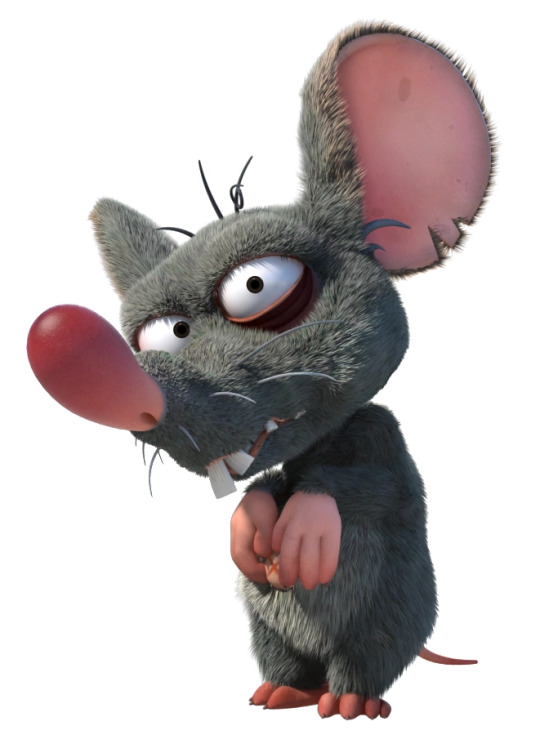
THANK YOU!!!!!! YES!!! YES!!!!

I wonder if the Larva series could hold up against the sheer majesty of a handsome little man like this? Look at the way he is sitting, yes, very distinguished!
13 notes
·
View notes
Video
youtube
Si tienes una Plaga en tu casa que haces? te diré que hacer! Te recomiendo lo lleves a cabo siempre que notes que necesitas una limpieza energética. Cuando notes cansancio, pensamiento negativo, desanimo sin causa aparente es un buen momento para realizar la llama violeta. También la puedes llevar a cabo en aquellos momentos por los que estás pasando por situaciones difíciles. INVOCACIÓN Y DECRETO AL RAYO VIOLETA. LIBERACIÓN Y LIMPIEZA PODEROSA. Utiliza las Sagrada Alquimia.
#youtube#alquimia#parasitos energeticos#larvas energeticas#larvas espirituales#larva series#te roban la energia
1 note
·
View note
Text

bishōjo mahou shoujo kaiju (.❛ ᴗ ❛.)✨️✨️✨️
#fanart#godzilla#mothra#godzilla king of the monsters#magical girls#mahou shoujo#mothzilla#I considered doing a series of this like w the other kaiju and fake screenshots etc#But. Is this too niche. Too self indulgent. Would I be doing it exclusively 4 me & myself 😐#I've been working thru the old movies and it's fun#Minilla and Mothras larva could b this versions chibi moon(s) 🥺#can’t decide if it’d be funnier if Godzilla still breathed radioactive fire or had a cutesty wand for it#mothras fairies are her lil mascots 🥹 …#gijinka#i guess???#godzilla gijinka#mothra gijinka#wait wait wait. imagine alt version of this but it’s based on shin Godzilla form 1 or 2 ajdkckdkfkc#this was going to be shin Godzillas final form actually but they (big toho) doesn’t want u to know that 🫤#I still do want that shin Godzilla plushie I’m ngl it’s kinda cute. tbh….#this post is queued ^_^
58 notes
·
View notes
Text
Varigo nation, i am so sorry
#please dont kill me#mom the dweller is howling again#tangled the series#rapunzels tangled adventure#varian and the seven kingdoms#vat7k#hugo rottewange#varigo#SATIRE SATIRE SATIRE S A T I R E#inspired by that insta reel of bigbird and yellow larvae
32 notes
·
View notes
Photo




Alter Ego class Tiamat (Larva) for the FGO X FGO/Arcade Collaboration event in Fate Grand Order.
Illustrator: Yamanaka Kotetsu
#Tiamat#Tiamat Larva#Tiamat / Larva#Larva#Alter Ego#Alter Ego Servant#Alter Ego Class#servant#character#Fate/Grand Order#Fate Grand Order#Fgo#Fate#Fate Go#Fate series#TYPE-MOON#typemoon#lasengle#art#illustration#illustrator#official art#official illustration#official illustrator#Yamanaka Kotetsu#mobile game#game#event#game event#game character
59 notes
·
View notes
Text
okay fine ill check out the foundation tv series
#i reread Prelude to Foundation a year ago but never got terribly far in the rest of the series#when i read them as an elementary/middle school larva
8 notes
·
View notes
Note
Can you do a palette for Larva Series rat the name Grey? Thank you!


293239 || #626f77 || #b1bcc0 || #b27a6d || #783b39
#grey the rat from the larva series palette#color palette#gray#pink#request#dec 21#this is the third time i've done a palettes for this guy#i've found the other two and made sure they've all been tagged consistently so if you want to see the other ones#just click on that first tag
28 notes
·
View notes
Text

CSI: Crime Scene Investigation (2000-2015) Sex, Lies and Larvae
S1E10
Sara and Grissom investigate the death of a woman, Kaye Shelton, found wrapped in a blanket in the mountains. With no way to confirm the time of death, Grissom relies on the insects found on her body to establish a timeline. Catherine and Warrick work on a case of a stolen painting. Nick works solo on a case of a missing wife.
#CSI: Crime Scene Investigation#Sex Lies and Larvae#tv series#2000 episode#crimes#murder#insects#stolen painting#Jorja Fox#crime investigation#CSI#mystery#S1E10#just watched
4 notes
·
View notes
Text
ok ok ok yuko might, biologically speaking, be in a similar state to how Power was when she (or rather, her blood) was allowed to access Pochita’s strength. A devil insofar as a fiend(/contractee?) whose devil “dna” has been allowed one way or another to eclipse the human parts despite maintaining the same consciousness. in both power and yuko’s case, by having their original bodies almost entirely destroyed and being regrown from a fraction of what’s left, resulting in a high enough ‘ratio’ to be functionally just an entire devil. actually makes me wonder how many seemingly full-fledged “devils” might have started out as fiends(/weird non-fiend edge cases/victims) that outgrew their own bodies.
#….is it like a life cycle???#chainsaw man spoilers#chainsaw man part 2 spoilers#ALSO raises questions about where contracts come in if some ‘devils’ are just straight-up ascended fiends#WAIT IF ITS A LIFE CYCLE THING AND FIENDS ARE LIKE. LARVAE. THAT COULD IMPLY THAT THEIR INABILITY TO FORM CONTRACTS IS A CONSENT THING#*IN ANY OTHER SERIES THAT’D FEEL LIKE A STRETCH BUT GIVEN ALL THE THEMES EVER I’M NOT SURE IT IS#that’d. also give them a way of having an earth-side rebirth cycle as well as in hell. which’d be wierd.#even if it DOES turn out to be a common way of devils ‘growing up’ i doubt it’d account for every devil#theres too many holes.#also ALSO even though i’ve brought up the fact that legally speaking fiends are considered incapable of consent i’m not really trying to imp#imply humans and fiends are incapable of person-to-person consentual relationships by saying they could be ‘larvae#like. devil-larvae theory puts them AHEAD of humans if we’re making shit directly analogous to a conventional ‘aging timeline’#it tying in with the broader themes of consent and ageism does not require it functioning in the same mechanical fashion in-universe#also like#incapable on a fundamental level of consentually forming relationships/‘contracts’ with devils =/= incapable of doing so with humans. all t#fucking parallels are assymetrical in this bitch
11 notes
·
View notes
Text
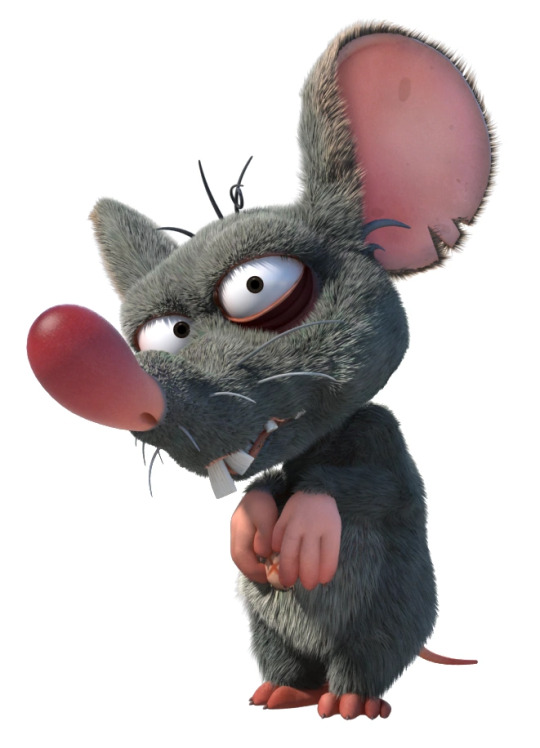
Today’s rat is Grey from Larva!
19 notes
·
View notes
Note
Pibby x Larva coming soon 2022 december 5th
Thanks for learning with pibby x larva crossover

Audio:
No Dialogue [Original]
English
German
French
Hungarian
Korean
Spanish
Turkish
Subtitles:
English
German
French
English (CC)
Hungarian
Korean
Spanish
Turkish
oh nice!
#Ask Me#Ask#Asks#Ask Me Stuff#Ask Me Anything#Ask Me Questions#Ask Me Some Stuff#isrrael120 Speaks#isrrael120 Asks#Ask Box#Ask Me Something#Ask Me Some Questions#Ask Me About Me#Ask Me To Tag#Ask Me Everything#My Asks#Ask Me LightBlueUni#isrrael120#adriennbanai-09#Larva Series#Learning With Pibby#Come And Learn With Pibby#Pibby Apocalypse#Learning With Pibby Apocalypse
11 notes
·
View notes
Text
Wool-Carder Bees: these solitary bees harvest the soft, downy hairs that grow on certain plants, rolling them into bundles and then using the material to line their nests

Wool-carder bees build their nests in existing cavities, usually finding a hole/crevice in a tree, a plant stem, a piece of rotting wood, or a man-made structure, and then lining the cavity with woolly plant fibers, which are used to form a series of brood cells.
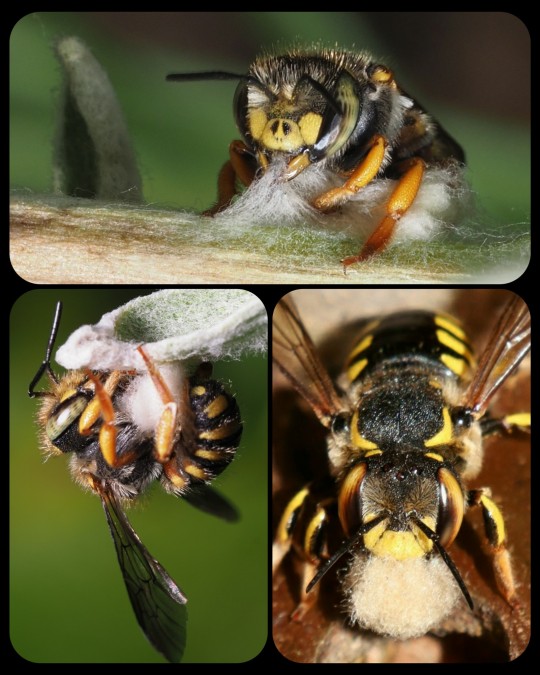
The fibers (known as trichomes) are collected from the leaves and stems of various plants, including lamb’s ear (Stachys byzantina), mulleins, globe thistle, rose campion, and other fuzzy plants.

From the University of Florida's Department of Entomology & Nematology:
The female uses her toothed mandibles to scrape trichomes off fuzzy plants and collects a ball of the material under her abdomen. She transports these soft plant fibers to her selected nest site and uses them to line a brood cell. Next, she collects and deposits a provision of pollen and nectar into the cell, enough pollen to feed a larva until it is ready to pupate. Lastly, she lays a single egg on top of the pollen and nectar supply before sealing the cell. ... She will repeat this process with adjoining cells until the cavity is full.
These are solitary bees, meaning that they do not form colonies or live together in hives. Each female builds her own nest, and the males do not have nests at all.
Female wool-carder bees will sometimes sting if their nest is threatened, but they are generally docile. The males are notoriously aggressive, however; they will often chase, head-butt, and/or wrestle any other insect that invades their territory, and they may defend their territory from intruders up to 70 times per hour. The males do not have stingers, but there are five tiny spikes located on the last segment of their abdomen, and they often use those spikes when fighting. They also have strong, sharp mandibles that can crush other bees.
There are many different types of wool-carder bee, but the most prolific is the European wool-carder (Anthidium manicatum), which is native to Europe, Asia, and North Africa, but has also become established as an invasive species throughout much of North America, most of South America, and New Zealand. It is the most widely distributed unmanaged bee in the world.
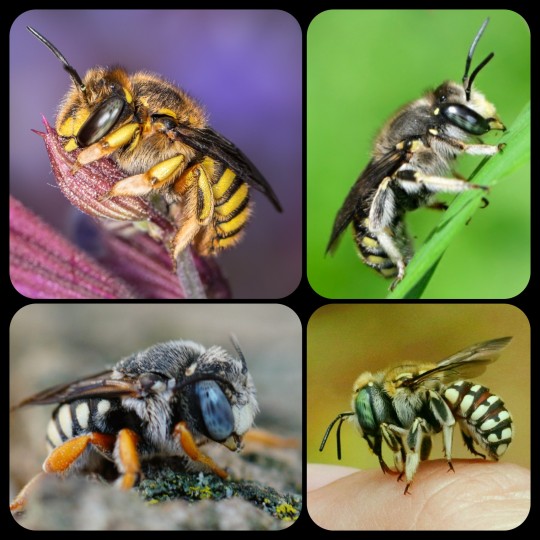
A few different species of wool-carder bee: the top row depicts the European wool-carder, A. manicatum (left) and the spotted wool-carder, Anthidium maculosum (right), while the bottom row depicts the reticulated small-woolcarder, Pseudoanthidium reticulatum, and Porter's wool-carder, Anthidium porterae
Sources & More Info:
University of Florida: The Woolcarder Bee
Oregon State University: European Woolcarder Bees
Bohart Museum of Entomology: Facts about the Wool Carder Bee (PDF)
Bumblebee Conservation Trust: A. manicatum
World's Best Gardening Blog: European Wool Carder Bees - Likeable Bullies
Biological Invasions: Global Invasion by Anthidium manicatum
#entomology#hymenoptera#apiology#melittology#bees#woolcarder bees#nature#insects#arthropods#science#solitary bees#european woolcarder#anthidium#animal facts#cool bugs#cute animals
3K notes
·
View notes
Text

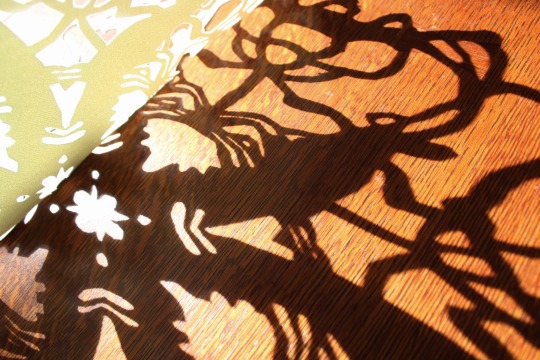

Stomatopoda Meshwork
2024, hand cut suede openwork, 16x16in
i’ve been connecting plankton and lace together in my mind for a couple of months and attempting to create designs inspired by both, and I think I finally cracked it. i was gifted some lovely white suede a while ago and finally was able to put it to use! I designed a lace doily pattern inspired by mantis shrimp larvae digitally, then transferred it to the suede and cut it out by hand with my fabric shears. I think the fragility and delicacy of plankton really gives itself to lace designs. really happy with this piece and wondering how I can make this a series of multiple different planktonic species all as doilies :)
#my art#art#queer artist#fiber art#lace#openwork#doily#suede#mantis shrimp#shrimp#marine biology#plankton#crustacean
159 notes
·
View notes
Text

Who lays the nectar eggs found in the Pikmin games? It might seem like a silly question, but for a series with such extensive lore surrounding its creatures it is surprising that it remains a mystery. Nectar eggs are a mysterious item found in Pikmin 2, Pikmin 3 and Pikmin 4. The eggs themselves are rarely acknowledged by the leaders and can contain a wide array of different things.
When broken, nectar eggs usually release a form of nectar or raw material. Curiously, there are also several creatures associated with these eggs, but it’s never been explicitly stated which actually produces them. Let’s look at the candidates:

Firstly, there are the Honeywisps. Honeywisps sometimes carry nectar eggs as they float through the air back to their nests. However, they don’t seem to be producing these eggs themselves, as in Pikmin 1 they can be seen carrying pure nectar collected from flowers.

Given they intend to feed the nectar from the nectar eggs they carry to their young, it seems more likely that they sometimes just steal nectar eggs from their nests of origin instead of collecting nectar from flowers.
“This timid creature flies around collecting nectar from flowers.”
[Source: Captain Olimar, Employee of Hocotate Freight and Captain of the S.S. Dolphin, Playable Character in Pikmin 1, December 2001]
“This creature collects nectar for the larvae waiting in its nest.”
[Source: Captain Olimar, Employee of Hocotate Freight and Captain of the S.S. Dolphin, Playable Character in Pikmin 1, December 2001]
“This cutie swims though the air with a heavy-looking nectar egg dangling below its translucent body on its way back to its nest where its offspring await lunch.”
[Source: Dalmo, Sozorian Animal Enthusiast and researcher, Non-Player Character in Pikmin 4, July 2023]

The next creatures are the Mitites. Mities are a type of insect that occasionally hatch from broken nectar eggs in great numbers and produce nectar when defeated, which initially makes them seem like good candidates for the producers of these eggs. However, the nectar eggs notably don’t resemble insect eggs - and for good reason! The Mitites are actually parasites that lay their eggs within the eggs of a “particular species”, with their larvae feeding on the nectar the eggs provide.

“These parasitic insects feed on eggs. Upon reaching maturity, they excrete a special pheromone that attracts females of particular species, enticing these females to swallow the mitites whole. (Pikmin, however, seem to dislike the scent.) After entering the host female's body, the mitites lay their own eggs inside the host's eggs just prior to the host spawning.”
[Source: Captain Olimar, Employee of Hocotate Freight and Captain of the S.S. Dolphin, Playable Character in Pikmin 2, August 2004]
“The cheeky Mitite lays its eggs inside the eggs of other creatures to provide its offspring with an easy first meal.”
[Source: Dalmo, Sozorian Animal Enthusiast and researcher, Non-Player Character in Pikmin 4, July 2023]

Similarly, the egg-like Sunsquishes can also be found within nectar eggs. These are explicitly “other creatures’ eggs”, making them a species that parasitises on the eggs like the Mitites.

“A type of primitive organism called a protochordate. In its juvenile state, it has a skeleton-like structure called a notochord. It flaps its finned tail to move and lives within other creatures' eggs as it grows.”
[Source: Captain Olimar, Employee of Hocotate Freight and Captain of the S.S. Dolphin, Playable Character in Pikmin 4, July 2023]

That leaves us with the Burrowing Snagrets. In Pikmin 4, Downy Snagrets, the infant form of the Burrowing Snagret, occasionally hatch from nectar eggs. These seem to be the most likely candidates for the actual producers of nectar eggs.

As established in a previous post, almost all extant life on PNF-404 is made up of nectar, which would extend to the nutrients in the egg yolk.
“Nectar is a vital source of nutrition that most life on this planet depends on. Whether it's in the form of an egg yolk, sap, or honey, I leave up to your imagination!”
[Source: Dalmo, Sozorian Animal Enthusiast and researcher, Non-Player Character in Pikmin 4, July 2023]



Nectar eggs also strongly resemble bird eggs and Burrowing Snagrets are certainly large enough to produce them. They’re also large enough to swallow Mitites whole and are even said to eat insects in the Piklopedia.
“The majority of snagret species lie in wait to ambush and capture prey, with a body type perfectly adapted to such sudden strikes. It violently attacks small, surface-dwelling insects.”
[Source: Captain Olimar, Employee of Hocotate Freight and Captain of the S.S. Dolphin, Playable Character in Pikmin 2, August 2004]
What’s more is that Snagret has the widest distribution of a species after the Bulborb, which explains why nectar eggs can be found all over the world across the Pikmin games.
“Distributed across a relatively wide range, subspecies of snagret suited to the varying soil conditions have emerged, making the snagret the most geographically represented species besides the bulborb.”
[Source: Captain Olimar, Employee of Hocotate Freight and Captain of the S.S. Dolphin, Playable Character in Pikmin 2, August 2004]
So in short, female Burrowing Snagrets lay their eggs. Those that are fertilised will produce Downy Snagrets, while unfertilised eggs will produce nectar. Sometimes, a female Burrowing Snagret will eat a Mitite, resulting in Mitite larvae hatching within and feeding on the eggs laid by the Burrowing Snagret. The larval Sunsquish also finds its way into these eggs, while Honeywisps occasionally steal the eggs to feed the nectar within then to their own larvae.

63 notes
·
View notes
Text

Lion's Mane Jellyfish (Cyanea capillata)
Family: Cyaneid Jellyfish Family (Cyaneidae)
IUCN Conservation Status: Unassessed
Named for its frilly "mane" made up of over 1,200 long, stinging tentacles, the Lion's Mane Jellyfish is among the largest known jellyfish species; while this viral image showing a diver next to a Lion's Mane Jellyfish has been edited to make the jellyfish appear far larger than it actually is, members of this species still dwarf most of their relatives, with a bell ("main body") diameter of over 2.4 meters (7.89 feet) and a tentacle length of as much as 30 meters (98.4 feet), making it one the longest animals on earth. Typically found near the surface in the Arctic, northern Atlantic and northern Pacific Ocean regions, Lion's Mane Jellyfishes, like all jellyfishes, lack brains, eyes, hearts or respiratory organs (instead exchanging gasses directly between the water around them and their extremely thin tissues,) and rely heavily on waves and ocean tides to travel, but are able to slowly propel themselves in a given direction by expanding the 8 bag-like lobes of their bodies to take in water and then forcing it out again to push themselves along (although they can also to some extent detect and react to their orientation and surroundings owing to a series of frilly sensory structures located around their body's rim, know as rhopalia.) Like most jellyfishes the long, trailing tentacles of a Lion's Mane Jellyfish are lined with touch-sensitive, harpoon-like cells called cnidocytes that fire venomous barbs into any animal that touches them, and after a tentacle has stung and ensnared suitable prey (mainly fish, large plankton and smaller jellyfishes) it is pulled back towards the body where the prey is passed through a mouth-like opening on the jellyfish's underside and into a simple body cavity where it is digested, with any indigestible matter, such as shells or bones, later being ejected from the body through the same opening it entered through. The life cycle of the Lion's Mane Jellyfish, like that of most jellyfishes, takes place in 4 distinct stages and seems highly elaborate compared to that of most animals; the bag-like adults that we typically think of as jellyfishes, known as medusas, are either male or female and reproduce sexually by releasing gametes into the water around them, and should these gametes meet they fuse and develop into tiny larvae. The larvae then settle onto a solid surface and develop into polyps (a second, immobile life stage resembling a sea anemone,) and each polyp then asexually reproduces several times, with genetically identical, slow-swimming young splitting off of its body as buds. Each of these asexually-produced individuals will then develop into a medusa, continuing the cycle and meaning that each single instance of sexual reproduction in Lion's Mane Jellyfishes produces multiple asexually-produced offspring. Despite their massive size medusas of this species only live for around a year, although their polyps, which only reproduce under ideal environmental conditions, may remain dormant for longer than this.
---------------------------------------------
Image Source: here
#Lion's Mane Jellyfish#jellyfish#jellyfishes#cnidarians#cnidarian#cnidology#animal#animals#zoology#invertebrate#invertebrates#marine biology#marine invertebrates#scyphozoa#wildlife#marine wildlife
171 notes
·
View notes